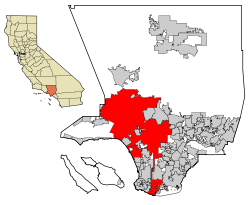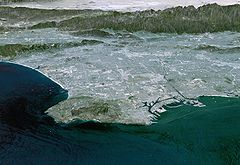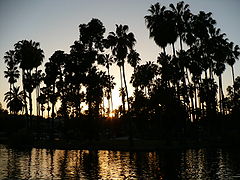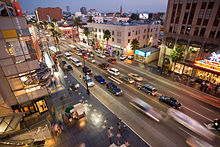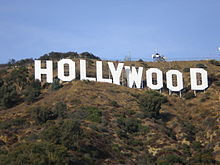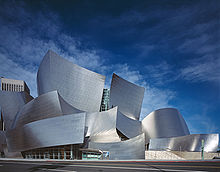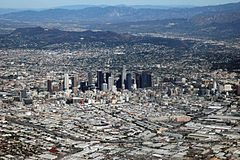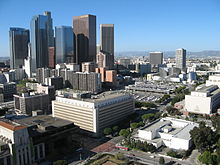- Los Angeles
-
"L.A." redirects here. For other uses, see La.This article is about the U.S. city. For other uses, see Los Angeles (disambiguation).
Los Angeles — City — Downtown Los Angeles, Venice, Griffith Observatory, Hollywood Sign 
Flag
SealNickname(s): L.A., the City of Angels,[1] Angeltown,[2] La-La Land[3] Location within Los Angeles County in the state of California Location in the United States Coordinates: 34°03′N 118°15′W / 34.05°N 118.25°WCoordinates: 34°03′N 118°15′W / 34.05°N 118.25°W Country United States State California County Los Angeles Settled September 4, 1781 Incorporated April 4, 1850 Government – Type Mayor-Council – Body Los Angeles City Council – Mayor Antonio Villaraigosa – City Attorney Carmen Trutanich – City Controller Wendy Greuel Area[4] – City 502.693 sq mi (1,301.970 km2) – Land 468.670 sq mi (1,213.850 km2) – Water 34.023 sq mi (88.119 km2) 6.77% Elevation 233 (city hall) ft (71 m) Population (2010) – City 3,792,621 – Rank (2nd US, 48th World) – Density 8,092.30/sq mi (3,124.5/km2) – Urban 14,940,000 – Metro 15,250,000 – CSA 17,786,419 2010 United States Census Demonym Angeleno Time zone PST (UTC-8) – Summer (DST) PDT (UTC−7) ZIP code 90001–90068, 90070–90084, 90086–90089, 90091, 90093–90097, 90099, 90101–90103, 90174, 90185, 90189, 90291-90293, 91040–91043, 91303–91308, 91342–91349, 91352–91353, 91356–91357, 91364–91367, 91401–91499, 91601–91609 Area code(s) 213, 310/424, 323, 661, 747/818 Website lacity.org Los Angeles (
 i/lɒs ˈændʒələs/ loss-an-jə-ləs; Spanish: [los ˈaŋxeles]), with a population at the 2010 United States Census of 3,792,621, is the most populous city in California[5] and the second most populous in the United States, after New York City,[6] on a land area of 468.67 square miles (1,213.8 km2), and is located in the southern region of the state. Often known by its initials LA, the city is the focal point of the larger Los Angeles-Long Beach-Santa Ana metropolitan statistical area, which contains 12,828,837 people as of 2010, and is one of the most populous metropolitan areas in the world[7] and the second largest in the United States.[8] Los Angeles is also the seat of Los Angeles County, the most populated and one of the most ethnically diverse counties[9] in the United States, while the Los Angeles area itself is the most diverse metropolitan area in the United States.[10] The city's inhabitants are referred to as "Angelenos" /ændʒɨˈliːnoʊz/.[11]
i/lɒs ˈændʒələs/ loss-an-jə-ləs; Spanish: [los ˈaŋxeles]), with a population at the 2010 United States Census of 3,792,621, is the most populous city in California[5] and the second most populous in the United States, after New York City,[6] on a land area of 468.67 square miles (1,213.8 km2), and is located in the southern region of the state. Often known by its initials LA, the city is the focal point of the larger Los Angeles-Long Beach-Santa Ana metropolitan statistical area, which contains 12,828,837 people as of 2010, and is one of the most populous metropolitan areas in the world[7] and the second largest in the United States.[8] Los Angeles is also the seat of Los Angeles County, the most populated and one of the most ethnically diverse counties[9] in the United States, while the Los Angeles area itself is the most diverse metropolitan area in the United States.[10] The city's inhabitants are referred to as "Angelenos" /ændʒɨˈliːnoʊz/.[11]Los Angeles was founded on September 4, 1781, by Spanish governor Felipe de Neve.[12] It became a part of Mexico in 1821 following the Mexican War of Independence.[13] In 1848, at the end of the Mexican–American War, Los Angeles and the rest of California were purchased as part of the Treaty of Guadalupe Hidalgo, thereby becoming part of the United States.[14] Los Angeles was incorporated as a municipality on April 4, 1850, five months before California achieved statehood.[15]
Nicknamed the City of Angels, Los Angeles is a world center of business, international trade, entertainment, culture, media, fashion, science, technology, and education. It is home to renowned institutions covering a broad range of professional and cultural fields and is one of the most substantial economic engines within the United States. Los Angeles has been ranked the third richest city and fifth most powerful and influential city in the world, behind only New York City in the United States.[16][17] The Los Angeles combined statistical area (CSA) has a gross metropolitan product (GMP) of $831 billion (as of 2008), making it the third largest economic center in the world, after the Greater Tokyo and New York metropolitan areas.[18] As the home base of Hollywood, it is known as the "Entertainment Capital of the World", leading the world in the creation of motion pictures, television production, video games, and recorded music. The importance of the entertainment business to the city has led many celebrities to call Los Angeles and its surrounding suburbs home. Los Angeles hosted the 1932 and 1984 Summer Olympics. Los Angeles is also home to renowned universities such as the University of Southern California and the University of California, Los Angeles.
Los Angeles enjoys a Mediterranean climate, with an average of 35 days with measurable precipitation annually.[19]
Contents
History
Main article: History of Los AngelesLos Angeles City Hall, shown here in 1931, was built in 1928 and was the tallest structure in the city until 1964, when height restrictions were removed.
The Los Angeles coastal area was first settled by the Tongva (or Gabrieleños) and Chumash Native American tribes thousands of years ago. Juan Rodríguez Cabrillo, a Portuguese-born explorer, claimed the area of southern California for the Spanish Empire in 1542.[20] Gaspar de Portolà and Franciscan missionary Juan Crespí, reached the present site of Los Angeles on August 2, 1769.[21]
In 1771, Franciscan friar Junípero Serra directed the building of the Mission San Gabriel Arcangel, the first mission in the area.[22] On September 4, 1781, a group of forty-four settlers known as "Los Pobladores" founded the town named El Pueblo de Nuestra Señora la Reina de los Ángeles del Río de Porciúncula (The Town of Our Lady the Queen of the Angels of the Porciúncula River).[23] Two-thirds of the settlers were mestizo or mulatto with African, Amerindian, and European ancestry.[24] The settlement remained a small ranch town for decades, but by 1820 the population had increased to about 650 residents.[25] Today, the pueblo is commemorated in the historic district of Los Angeles Pueblo Plaza and Olvera Street, the oldest part of Los Angeles.[26]
New Spain achieved its independence from the Spanish Empire in 1821, and the pueblo continued as a part of Mexico. During Mexican rule, Governor Pío Pico, made Los Angeles Alta California's regional capital. Mexican rule ended during the Mexican–American War: Americans took control from the Californios after a series of battles, culminating with the signing of the Treaty of Cahuenga on January 13, 1847.[27]
Railroads arrived with the completion of the Southern Pacific line to Los Angeles in 1876.[28] Oil was discovered in 1892, and by 1923, the discoveries had helped California become the country's largest oil producer, accounting for about one-quarter of the world's petroleum output.[29]
By 1900, the population had grown to more than 102,000 people,[30] putting pressure on the city's water supply.[31] The completion of the Los Angeles Aqueduct in 1913, under the supervision of William Mulholland, assured the continued growth of the city.[32]
In 1910, not only had the city of Los Angeles just annexed Hollywood, but there were already at least ten movie companies operating in the city. By 1921, more than 80% of the world's film industry was concentrated in L.A.[33] The money generated by the industry kept the city relatively insulated from much of the economic pain suffered by the rest of the country during the Great Depression.[34] By 1930, the population surpassed one million.[35] In 1932, the city hosted the Summer Olympics.
After the second world war, the city grew more rapidly than ever, sprawling into the San Fernando Valley.[36] In 1969, Los Angeles became one of the birthplaces of the Internet, as the first ARPANET transmission was sent from the University of California, Los Angeles (UCLA) to SRI in Menlo Park.[37]
In 1984, the city hosted the Summer Olympic Games for the second time. Despite being boycotted by 14 Communist countries, the 1984 Olympics became vastly more financially successful than any previous,[38] and only the second Olympics to turn a profit until then – the other, according to an analysis of contemporary newspaper reports, being the 1932 Summer Olympics, also held in Los Angeles.[39]
Racial tensions erupted on April 29, 1992, with the acquittal by a Simi Valley jury of the police officers captured on videotape beating Rodney King, culminating in large-scale riots.[40] In 1994, the 6.7 Northridge earthquake shook the city, causing $12.5 billion in damage and 72 deaths.[41] The century ended with the Rampart scandal, one of the most extensive cases of police misconduct in American history.[42]
Voters defeated efforts by the San Fernando Valley and Hollywood to secede from the city in 2002.[43]
Geography
See also: Los Angeles Basin, San Fernando Valley, Greater Los Angeles area, and Los Angeles County, CaliforniaTopography
Los Angeles is irregularly shaped and covers a total area of 502.7 square miles (1,302 km2), comprising 468.7 square miles (1,214 km2) of land and 34.0 square miles (88 km2) of water.[4] The city extends for 44 miles (71 km) longitudinally and for 29 miles (47 km) latitudinally. The perimeter of the city is 342 miles (550 km).
Los Angeles is both flat and hilly. The highest point in the city is 5,074 ft (1,547 m) Mount Lukens,[44][45] located at the northeastern end of the San Fernando Valley. The eastern end of the Santa Monica Mountains stretches from Downtown to the Pacific Ocean and separates the Los Angeles Basin from the San Fernando Valley. Other hilly parts of Los Angeles include the Mt. Washington area north of Downtown, eastern parts such as Boyle Heights, the Crenshaw district around the Baldwin Hills, and the San Pedro district.
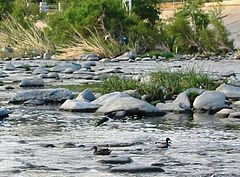 Mallards on the Los Angeles River
Mallards on the Los Angeles River
The Los Angeles River, which is largely seasonal, is the primary drainage channel. It was straightened and lined in 51 miles of concrete by the Army Corps of Engineers to act as a flood control channel.[46] The river begins in the Canoga Park district of the city, flows east from the San Fernando Valley along the north edge of the Santa Monica Mountains, and turns south through the city center, flowing to its mouth in the Port of Long Beach at the Pacific Ocean. The smaller Ballona Creek flows into the Santa Monica Bay at Playa del Rey.
The Los Angeles area is rich in native plant species due in part to a diversity in habitats, including beaches, wetlands, and mountains. The most prevalent botanical environment is coastal sage scrub,[47] which covers the hillsides in combustible chaparral. Native plants include: California poppy, matilija poppy, toyon, Coast Live Oak, and Giant Wildrye. Many of these native species, such as the Los Angeles sunflower, have become so rare as to be considered endangered. Though it is not native to the area, the official tree of Los Angeles is the Coral Tree (Erythrina caffra)[48] and the official flower of Los Angeles is the Bird of Paradise (Strelitzia reginae).[49] Mexican Fan Palms, California Fan Palms, and Canary Island Palms can be seen throughout the Los Angeles area, despite the latter being non-indigenous to Southern California.
Geology
Los Angeles is subject to earthquakes due to its location on the Pacific Ring of Fire. The geologic instability has produced numerous faults, which cause approximately 10,000 earthquakes annually.[50] One of the major faults is the San Andreas Fault. Located at the boundary between the Pacific Plate and the North American Plate, it is predicted to be the source of Southern California's next big earthquake.[51] Major earthquakes to have hit the Los Angeles area include the 1994 Northridge earthquake, the 1987 Whittier Narrows earthquake, the 1971 San Fernando earthquake near Sylmar, and the 1933 Long Beach earthquake. Nevertheless, all but a few quakes are of low intensity and are not felt.[50] The Los Angeles basin and metropolitan area are also at risk from blind thrust earthquakes.[52] Parts of the city are also vulnerable to tsunamis; harbor areas were damaged by waves from the Valdivia earthquake in 1960.[53]
Climate
Main article: Climate of the Los Angeles BasinEcho Park as seen with palm trees
Los Angeles has a Subtropical-Mediterranean climate (Köppen climate classification Csb on the coast, Csa inland), and receives just enough annual precipitation to avoid Köppen's BSh (semi-arid climate) classification. Los Angeles enjoys plenty of sunshine throughout the year, with an average of only 35 days with measurable precipitation annually.[19]
The average annual temperature in downtown is 66 °F (19 °C): 75 °F (24 °C) during the day and 57 °F (14 °C) at night. In the coldest month, January, the temperature typically ranges from 59 to 73 °F (15 to 23 °C) during the day and 45 to 55 °F (7 to 13 °C) at night. In the warmest month – August – the temperature typically ranges from 79 to 90 °F (26 to 32 °C) during the day and around 64 °F (18 °C) at night. Temperatures exceed 90 °F (32 °C) on a dozen or so days in the year, from one day a month in April, May, June and November to three days a month in July, August, October and to five days in September.[19] Temperatures are subject to substantial daily swings; in inland areas the difference between the average daily low and the average daily high is over 30 °F (17 °C).[54] The average annual temperature of the sea is 63 °F (17 °C), from 58 °F (14 °C) in January to 68 °F (20 °C) in August.[55] Hours of sunshine total more than 3,000 per year, from an average of 7 hours of sunshine per day in December to an average of 12 in July.[56]
The Los Angeles area is also subject to phenomena typical of a microclimate, causing extreme variations in temperature in close physical proximity to each other. For instance, the average July maximum temperature at the Santa Monica Pier is 75 °F (24 °C) whereas it is 95 °F (35 °C) in Canoga Park.[57] The city, like much of the southern California coast, is subject to a late spring/early summer weather phenomenon called "June Gloom." This involves overcast or foggy skies in the morning which yield to sun by early afternoon.[58]
Downtown Los Angeles averages 15.14 inches (384.6 mm) of precipitation annually, which mainly occurs during the winter and spring (November through April) with generally moderate rain showers, but usually as heavy rainfall and thunderstorms during Winter storms. The coast gets slightly less rainfall, while the mountains get slightly more. However the San Fernando Valley Region of Los Angeles can get between 16 and 20 inches (410 and 510 mm) of rain per year. Years of average rainfall are rare; the usual pattern is bimodal, with a short string of dry years (perhaps 7–8 inches/180–200 millimetres) followed by one or two wet years that make up the average. Snowfall is extremely rare in the city basin, but the mountains within city limits typically receive snowfall every winter. The greatest snowfall recorded in downtown Los Angeles was 2 inches (5 cm) in 1932.[59] The highest recorded temperature in downtown Los Angeles is 113 °F (45 °C) on September 27, 2010[60] and the lowest recorded temperature is 24 °F (−4 °C) on December 22, 1944.
Climate data for Los Angeles (Downtown - USC campus) Month Jan Feb Mar Apr May Jun Jul Aug Sep Oct Nov Dec Year Average high °F (°C) 68.1
(20.1)69.6
(20.9)69.8
(21.0)73.1
(22.8)74.5
(23.6)79.5
(26.4)83.8
(28.8)84.8
(29.3)83.3
(28.5)79.0
(26.1)73.2
(22.9)68.7
(20.4)75.6 Daily mean °F (°C) 58.3
(14.6)60.0
(15.6)60.7
(15.9)63.8
(17.7)66.2
(19.0)70.5
(21.4)74.2
(23.4)75.2
(24.0)74.0
(23.3)69.5
(20.8)62.9
(17.2)58.5
(14.7)66.2 Average low °F (°C) 48.5
(9.2)50.3
(10.2)51.6
(10.9)54.4
(12.4)57.9
(14.4)61.4
(16.3)64.6
(18.1)65.6
(18.7)64.6
(18.1)59.9
(15.5)52.6
(11.4)48.3
(9.1)56.6 Rainfall inches (mm) 3.33
(84.6)3.68
(93.5)3.14
(79.8)0.83
(21.1)0.31
(7.9)0.06
(1.5)0.01
(0.3)0.13
(3.3)0.32
(8.1)0.37
(9.4)1.05
(26.7)1.91
(48.5)15.14
(384.6)Avg. rainy days (≥ 0.01 inch) 6.5 6.0 6.4 3.0 1.3 0.6 0.3 0.5 1.2 2.0 3.1 4.3 35.2 Sunshine hours 225.3 222.5 267.0 303.5 276.2 275.8 364.1 349.5 278.5 255.1 217.3 219.4 3,254.2 Source: NOAA[61] Climate data for Los Angeles (LAX, at the coast) Month Jan Feb Mar Apr May Jun Jul Aug Sep Oct Nov Dec Year Average high °F (°C) 65.6
(18.7)65.8
(18.8)65.3
(18.5)68.0
(20.0)69.3
(20.7)72.6
(22.6)75.3
(24.1)76.8
(24.9)76.5
(24.7)74.3
(23.5)70.4
(21.3)66.7
(19.3)70.6 Daily mean °F (°C) 57.1
(13.9)58.0
(14.4)58.3
(14.6)60.8
(16.0)63.1
(17.3)66.4
(19.1)69.3
(20.7)70.7
(21.5)70.1
(21.2)66.9
(19.4)61.6
(16.4)57.6
(14.2)63.3 Average low °F (°C) 48.6
(9.2)50.1
(10.1)51.3
(10.7)53.6
(12.0)56.9
(13.8)60.1
(15.6)63.3
(17.4)64.5
(18.1)63.6
(17.6)59.4
(15.2)52.7
(11.5)48.5
(9.2)56.1 Rainfall inches (mm) 2.98
(75.7)3.11
(79)2.40
(61)0.63
(16)0.24
(6.1)0.08
(2)0.03
(0.8)0.14
(3.6)0.26
(6.6)0.36
(9.1)1.13
(28.7)1.79
(45.5)13.15
(334)Avg. rainy days (≥ 0.01 in) 6.4 6.3 6.5 2.6 1.3 0.5 0.4 0.5 1.2 2.0 3.1 4.7 35.5 Source: National Oceanic and Atmospheric Administration[61] Climate data for Los Angeles (Canoga Park, in the San Fernando Valley) Month Jan Feb Mar Apr May Jun Jul Aug Sep Oct Nov Dec Year Average high °F (°C) 67.9
(19.9)69.9
(21.1)72.0
(22.2)77.7
(25.4)81.3
(27.4)88.8
(31.6)95.0
(35.0)96.0
(35.6)91.7
(33.2)84.4
(29.1)74.7
(23.7)68.8
(20.4)80.7 Daily mean °F (°C) 53.7
(12.1)55.4
(13.0)57.2
(14.0)61.3
(16.3)65.2
(18.4)71.0
(21.7)76.0
(24.4)76.8
(24.9)73.5
(23.1)66.8
(19.3)58.2
(14.6)53.6
(12.0)64.1 Average low °F (°C) 39.5
(4.2)40.9
(4.9)42.3
(5.7)44.8
(7.1)49.1
(9.5)53.2
(11.8)56.9
(13.8)57.6
(14.2)55.2
(12.9)49.2
(9.6)41.7
(5.4)38.3
(3.5)47.4 Rainfall inches (mm) 3.83
(97.3)4.40
(111.8)3.60
(91.4)0.88
(22.4)0.32
(8.1)0.07
(1.8)0.01
(0.3)0.15
(3.8)0.24
(6.1)0.62
(15.7)1.29
(32.8)2.38
(60.5)17.79
(451.9)Avg. rainy days (≥ 0.01 in) 6.2 5.9 6.1 3.0 1.3 0.4 0.1 0.7 1.3 2.0 3.2 4.4 34.6 Source: NOAA[54] Cityscape
Main article: List of districts and neighborhoods of Los Angeles
Panorama of Los Angeles as viewed from Mulholland Drive. Left to right: Santa Ana Mountains, downtown, Hollywood (foreground), Wilshire Boulevard, Port of Los Angeles, Palos Verdes Peninsula, Santa Catalina Island, and Los Angeles International Airport. The city is divided into over 80 districts and neighborhoods,[62] many of which were incorporated places or communities that were annexed by the city.[63] Greater Los Angeles includes a number of enclaves and nearby communities. Generally, the city is divided into the following areas: Downtown Los Angeles, East Los Angeles and Northeast Los Angeles, South Los Angeles (still often colloquially referred to as South Central by locals), the Harbor Area, Greater Hollywood, Wilshire, the Westside and the San Fernando and Crescenta Valleys.
Some well-known communities within Los Angeles include West Adams, Watts, Leimert Park, Baldwin Hills, Venice, the Downtown Financial District, Los Feliz, Silver Lake, Hollywood, Koreatown, Westwood and the more affluent areas of Bel Air, Benedict Canyon, Hollywood Hills, Hancock Park, Pacific Palisades, Century City, and Brentwood.
Landmarks
See also: Category:Landmarks in Los Angeles, California, List of sites of interest in the Los Angeles area, and National Register of Historic Places listings in Los Angeles, CaliforniaImportant landmarks in Los Angeles include Walt Disney Concert Hall, the Kodak Theatre, the Griffith Observatory, the Getty Center, the Getty Villa, the Los Angeles Memorial Coliseum, the Los Angeles County Museum of Art, Grauman's Chinese Theatre, the Hollywood Sign, the Bradbury Building, Hollywood Boulevard, the Capitol Records Building, Los Angeles City Hall, the Hollywood Bowl, the Theme Building, the Watts Towers, Staples Center, Dodger Stadium, and La Placita Olvera/Olvera Street.
Culture
Main article: Arts and culture of Los AngelesLos Angeles is often billed as the "Creative Capital of the World", due to the fact that one in every six of its residents works in a creative industry.[64] According to the USC Stevens Institute for Innovation, "there are more artists, writers, filmmakers, actors, dancers and musicians living and working in Los Angeles than any other city at any time in the history of civilization."[65]
Los Angeles is home to Hollywood, globally recognized as the epicenter of the motion picture industry. A testament to its preeminence in film, the city plays host to the annual Academy Awards, the oldest and one of the most prominent award ceremonies in the world. Finally, Los Angeles is home to the USC School of Cinematic Arts, the oldest film school in the United States.[66]
The performing arts play a major role in Los Angeles' cultural identity. According to the USC Stevens Institute for Innovation, "there are more than 1,100 annual theatrical productions and 21 openings every week."[65] The Los Angeles Music Center is "one of the three largest performing arts centers in the nation," with more than 1.3 million visitors per year.[67] The Walt Disney Concert Hall, centerpiece of the Music Center, is home to the prestigious Los Angeles Philharmonic. Notable organizations such as Center Theatre Group, the Los Angeles Master Chorale, and the Los Angeles Opera are also resident companies of the Music Center. Talent is locally cultivated at premier institutions such as the Colburn School and the USC Thornton School of Music.
Museums and galleries
See also: Los Angeles City MuseumsThere are 841 museums and art galleries in Los Angeles County.[68] In fact, Los Angeles has more museums per capita than any other city in the world.[68] Some of the notable museums are the Los Angeles County Museum of Art (the largest art museum in the Western United States[69]), the Getty Center (part of the larger J. Paul Getty Trust, the world's wealthiest art institution[70]), and the Museum of Contemporary Art. A significant number of art galleries are located on Gallery Row, and tens of thousands attend the monthly Downtown Art Walk there.[71]
Media
Main article: Media in Los Angeles The Fox Plaza in Century City, headquarters for 20th Century Fox, is a major financial district for West Los Angeles
The Fox Plaza in Century City, headquarters for 20th Century Fox, is a major financial district for West Los Angeles
The major daily English-language newspaper in the area is the Los Angeles Times. La Opinión is the city's major daily Spanish-language paper, and The Korea Times is the city's major daily Korean-language paper. Investor's Business Daily is distributed from its L.A. corporate offices, which are headquartered in Playa Del Rey. There are also a number of smaller regional newspapers, alternative weeklies and magazines, including the Daily News (which focuses coverage on the San Fernando Valley), LA Weekly, Los Angeles CityBeat, L.A. Record (which focuses coverage on the music scene in the Greater Los Angeles Area), Los Angeles magazine, Los Angeles Business Journal, Los Angeles Daily Journal (legal industry paper), The Hollywood Reporter and Variety (entertainment industry papers), and Los Angeles Downtown News. In addition to the major papers, numerous local periodicals serve immigrant communities in their native languages, including Armenian, English, Korean, Persian, Russian, Chinese, Japanese, Hebrew, and Arabic. Many cities adjacent to Los Angeles also have their own daily newspapers whose coverage and availability overlaps into certain Los Angeles neighborhoods. Examples include The Daily Breeze (serving the South Bay), and The Long Beach Press-Telegram.
Los Angeles and New York City are the only two media markets to have seven VHF allocations assigned to them.[72]
The city has major broadcast channels as well as three PBS stations. World TV operates on two channels and the area has several Spanish-language television networks. KTBN 40 is the flagship station of the religious Trinity Broadcasting Network, based out of Santa Ana. A variety of independent television stations also operate in the area.
Sports
Los Angeles is the home of the Los Angeles Dodgers of Major League Baseball, the Los Angeles Kings of the National Hockey League, the Los Angeles Clippers and Los Angeles Lakers of the National Basketball Association, the Los Angeles D-Fenders, an NBA Development team owned by the Los Angeles Lakers, and the Los Angeles Sparks of the Women's National Basketball Association. Los Angeles is also home to the USC Trojans and the UCLA Bruins in the NCAA, both of which are Division I teams in the Pacific-12 Conference. The Los Angeles Galaxy and Club Deportivo Chivas USA of Major League Soccer are based in Carson.
Los Angeles is the second-largest city and television market in the United States, but has no NFL team. the nearest team is located in San Diego and are called the Chargers. At one time Los Angeles had two NFL teams, the Rams and the Raiders. Both left the city in 1995, with the Rams moving to St. Louis and the Raiders heading back to their original home of Oakland. Prior to 1995, the Rams called Memorial Coliseum home (1946–1979) and the Raiders played their home games at Memorial Coliseum from 1982 to 1994.
 Staples Center, a premier venue for sports and entertainment, is home to five professional sports teams, most notably the Los Angeles Lakers
Staples Center, a premier venue for sports and entertainment, is home to five professional sports teams, most notably the Los Angeles Lakers
Since the franchise's departures the NFL as an organization, and individual NFL owners, have attempted to relocate a team to the city. Immediately following the 1995 NFL season, Seattle Seahawks owner Ken Behring went as far as packing up moving vans to start play in the Rose Bowl under a new team name and logo for the 1996 season. The State of Washington filed a lawsuit to prevent the move.[73] In 2003, then-NFL Commissioner Paul Tagliabue said that he thought that Los Angeles would get a new expansion team, a thirty-third franchise, after the choice of Houston over Los Angeles in the 2002 league expansion round.[74] Despite these efforts, and the failure to build a new stadium for an NFL team, Los Angeles is still expected to return to the league through expansion or relocation. On August 9, 2011 the LA City Council approved plans to build Farmers Field, which will become home to an NFL team in the future. The stadium is expected to be completed by 2016.[75]
Los Angeles has twice played host to the Summer Olympic Games, in 1932 and in 1984. When the tenth Olympic Games were hosted in 1932, the former 10th Street was renamed Olympic Blvd. Super Bowls I and VII were also held in the city as well as multiple FIFA World Cup games in 1994 including the final. Los Angeles will host the Special Olympics World Summer Games in 2015.[76]
Los Angeles also boasts a number of sports venues, including Dodger Stadium, Los Angeles Coliseum, The Forum, Staples Center, a sports and entertainment complex that also hosts concerts and awards shows such as the Grammys. Staples Center also serves as the home arena for the Los Angeles Clippers and Los Angeles Lakers of the NBA, the Los Angeles Sparks of the WNBA, and the Los Angeles Kings of the NHL. It was also home to the Los Angeles Avengers of the original AFL, a team that did not participate in that league's ongoing revival.
The Los Angeles Angels of Anaheim of Major League Baseball and the Anaheim Ducks of the National Hockey League are in the Los Angeles media market and are based in Anaheim in Orange County. The Angels began as an expansion franchise team in Los Angeles in 1961 and played at Los Angeles' Wrigley Field and then Dodger Stadium before moving to Anaheim in 1966.[77] The Ducks, who have played in Anaheim since their inception as an expansion team in 1993, were originally owned by Disney and known as the Mighty Ducks of Anaheim, after the popular Disney film. The team adopted its current name in 2006, a year after Disney sold the franchise.[78]
Religion
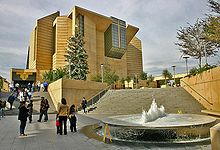 Cathedral of Our Lady of the Angels is the mother cathedral for the Los Angeles archdiocese
Cathedral of Our Lady of the Angels is the mother cathedral for the Los Angeles archdiocese
The Roman Catholic Archbishop of Los Angeles leads the largest archdiocese in the country.[79] Cardinal Roger Mahony oversaw construction of the Cathedral of Our Lady of the Angels, which opened in September, 2002 in downtown Los Angeles.[80] Construction of the cathedral marked a coming of age of the city's Catholic, heavily Latino community. There are numerous Catholic churches and parishes throughout Los Angeles.
With 621,000 Jews in the metropolitan area (490,000 in city proper), the region has the second largest population of Jews in the United States.[81] Many of Los Angeles' Jews now live on the Westside and in the San Fernando Valley, though Boyle Heights and Northwest Los Angeles once had large Jewish populations. Many varieties of Judaism are represented in the area, including Reform, Conservative, Orthodox, and Reconstructionist.The Breed Street Shul in East Los Angeles, built in 1923, was the largest synagogue west of Chicago in its early decades.[82] (It is no longer a sacred space and is being converted to a museum and community center.)[83] The Kabbalah Centre also has a presence in the city.[84]
Los Angeles has had a rich and influential Protestant tradition. The first Protestant service in Los Angeles was a Methodist meeting held in a private home in 1850 and the oldest Protestant church still operating was founded in 1867. In the early 1900s the Bible Institute Of Los Angeles published the founding documents of the Christian Fundamentalist movement and the Azusa Street Revival launched Pentecostalism. Aimee Semple McPherson broadcast over the radio in the 1920s from the Angelus Temple, home of the International Church of the Foursquare Gospel and its Life Pacific College. The Potter's House Christian Fellowship and Metropolitan Community Church also had their origins in the city. Billy Graham's first big success came in L.A. and notable ministers connected to the city include Robert P. Shuler, Charles E. Fuller, Gene Scott, Jesse Lee Peterson, and Solomon Burke. Important churches in the city include First Presbyterian Church of Hollywood, Bel Air Presbyterian Church, First African Methodist Episcopal Church of Los Angeles, West Angeles Church of God in Christ, Second Baptist Church, Crenshaw Christian Center, McCarty Memorial Christian Church, and First Congregational Church.
 Built in 1956, the Los Angeles California Temple of The Church of Jesus Christ of Latter-day Saints is the second largest Mormon temple in the world
Built in 1956, the Los Angeles California Temple of The Church of Jesus Christ of Latter-day Saints is the second largest Mormon temple in the world
The Los Angeles California Temple, the second largest temple operated by The Church of Jesus Christ of Latter-day Saints, is on Santa Monica Boulevard in the Westwood district of Los Angeles. Dedicated in 1956, it was the first Mormon temple built in California and it was the largest in the world when completed.[85]
The Hollywood region of Los Angeles also has several significant headquarters, churches, and the Celebrity Center of Scientology.
Because of Los Angeles' large multi-ethnic population, a wide variety of faiths are practiced, including Islam, Buddhism, Hinduism, Zoroastrianism, Sikhism, Bahá'í, various Eastern Orthodox Churches, Sufism and others. Immigrants from Asia for example, have formed a number of significant Buddhist congregations making the city home to the greatest variety of Buddhists in the world.
Economy
Further information: Los Angeles County EconomySee also: Los Angeles Chamber of Commerce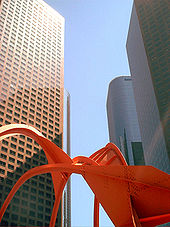 Companies such as US Bancorp, Ernst & Young, Aon, Manulife Financial, City National Bank, Wells Fargo, Bank of America, Deloitte, KPMG and the Union Bank of California have offices in the Downtown Financial District
Companies such as US Bancorp, Ernst & Young, Aon, Manulife Financial, City National Bank, Wells Fargo, Bank of America, Deloitte, KPMG and the Union Bank of California have offices in the Downtown Financial District
The economy of Los Angeles is driven by international trade, entertainment (television, motion pictures, video games, recorded music), aerospace, technology, petroleum, fashion, apparel, and tourism. Los Angeles is also the largest manufacturing center in the western United States.[86] The contiguous ports of Los Angeles and Long Beach together comprise the fifth-busiest port in the world and the most significant port in the Western Hemisphere and is vital to trade within the Pacific Rim.[86] Other significant industries include media production, finance, telecommunications, law, healthcare, and transportation. The Los Angeles-Long Beach-Santa Ana metropolitan statistical area (MSA) has a gross metropolitan product (GMP) of $735.7 billion (as of 2010),[87] making it the third largest economic center in the world, after the Greater Tokyo Area and the New York-Newark-Bridgeport CSA.[18] If counted as a country, the surrounding CSA has the 15th largest economy in the world in terms of nominal GDP.[88] Los Angeles has been classified an "Alpha world city" according to a 2010 study by a research group at Loughborough University in England.[89]
The city is home to seven Fortune 500 companies. They are aerospace contractor Northrop Grumman, energy company Occidental Petroleum, healthcare provider Health Net, metals distributor Reliance Steel & Aluminum, engineering firm AECOM, real estate group CB Richard Ellis and builder Tutor Perini.
Other companies headquartered in Los Angeles include California Pizza Kitchen, Capital Group, Capstone Turbine, Cathay Bank, City National Bank, The Coffee Bean & Tea Leaf, DeviantArt, Far East National Bank, Farmers Insurance Group, Fox Entertainment Group, Gibson, Dunn & Crutcher, Guess?, Hanmi Bank, Herbalife, J2 Global Communications, The Jim Henson Company, KB Home, Korn/Ferry, Latham & Watkins, Mercury Insurance Group, Oaktree Capital Management, O’Melveny & Myers; Paul, Hastings, Janofsky & Walker, Premier America, Premiere Radio Networks, Rentech, Roll International, Sunkist, The TCW Group, Tokyopop, Triton Media Group, United Online, and VCA Antech.
The metropolitan area contains the headquarters of companies who moved outside of the city to escape its taxes but keep the benefits of proximity. For example, Los Angeles charges a gross receipts tax based on a percentage of business revenue, while many neighboring cities charge only small flat fees.[90]
The University of Southern California (USC) is the city's largest private sector employer and contributes $4 billion annually to the local economy.[91]
According to the city's 2010 Comprehensive Annual Financial Report, the top ten employers in the city as of 2009 are, in descending order, the City of Los Angeles, the County of Los Angeles, University of California, Los Angeles, University of Southern California, Cedars-Sinai Medical Center, Kaiser Permanente, Fox Entertainment Group, Farmers Insurance Group, TeamOne,and Northrop Grumman.[92]
Education
Colleges and universities
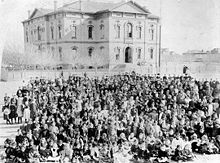 Second branch of the California State Normal School in downtown Los Angeles opened its doors in 1882.
Second branch of the California State Normal School in downtown Los Angeles opened its doors in 1882.
There are three public universities located within the city limits: California State University, Los Angeles (CSULA), California State University, Northridge (CSUN) and University of California, Los Angeles (UCLA). Private colleges in the city include the American Film Institute Conservatory, Alliant International University, Syracuse University (Los Angeles Campus), American InterContinental University, American Jewish University, The American Musical and Dramatic Academy – Los Angeles campus, Antioch University's Los Angeles campus, Charles R. Drew University of Medicine and Science, Fashion Institute of Design & Merchandising's Los Angeles campus (FIDM), Los Angeles Film School, Loyola Marymount University (LMU is also the parent university of Loyola Law School located in Los Angeles), Marymount College, Mount St. Mary's College, National University of California, Occidental College ("Oxy"), Otis College of Art and Design (Otis), Southern California Institute of Architecture (SCI-Arc), Southwestern Law School, and University of Southern California (USC).
The community college system consists of nine campuses governed by the trustees of the Los Angeles Community College District: East Los Angeles College (ELAC), Los Angeles City College (LACC), Los Angeles Harbor College, Los Angeles Mission College, Los Angeles Pierce College, Los Angeles Valley College (LAVC), Los Angeles Southwest College, Los Angeles Trade-Technical College and West Los Angeles College.
Schools and libraries
See also: Los Angeles County, California#Colleges and universities and List of high schools in Los Angeles County, CaliforniaLos Angeles Unified School District serves almost all of the city of Los Angeles, as well as several surrounding communities, with a student population around 800,000.[93] After Proposition 13 was approved in 1978, urban school districts had considerable trouble with funding. LAUSD has become known for its underfunded, overcrowded and poorly maintained campuses, although its 162 Magnet schools help compete with local private schools.[94] Several small sections of Los Angeles are in the Las Virgenes Unified School District. Los Angeles County Office of Education operates the Los Angeles County High School for the Arts. The Los Angeles Public Library system operates 72 public libraries in the city.[95] Enclaves of unincorporated areas are served by the County of Los Angeles Public Library, many are within walking distance to City of Los Angeles residents.
Transportation
Main article: Transportation in Los AngelesFreeways
Main article: Southern California freewaysThe city and the rest of the Los Angeles metropolitan area is served by an extensive network of freeways and highways. The Texas Transportation Institute, which publishes an annual Urban Mobility Report, ranked Los Angeles road traffic as the most congested in the United States in 2005 as measured by annual delay per traveler.[96] The average traveler in Los Angeles experienced 72 hours of traffic delay per year according to the study. Los Angeles was followed by San Francisco/Oakland, Washington, D.C. and Atlanta, (each with 60 hours of delay).[97] Despite the congestion in the city, the mean travel time for commuters in Los Angeles is shorter than other major cities, including New York City, Philadelphia and Chicago. Los Angeles' mean travel time for work commutes in 2006 was 29.2 minutes, similar to those of San Francisco and Washington, D.C.[98]
Among the major highways that connect LA to the rest of the nation include Interstate 5, which runs south through San Diego to Tijuana in Mexico and then north to the Canadian border through Sacramento, Portland, and Seattle; Interstate 10, the southernmost east–west, coast-to-coast Interstate Highway in the United States, going to Jacksonville, Florida; and U.S. Route 101, which heads to the California Central Coast, San Francisco, the Redwood Empire, and the Oregon and Washington coasts.
Transit systems
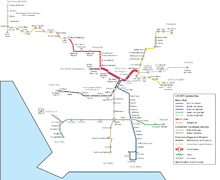 Current Los Angeles Metro Rail map showing existing and under-construction lines.
Current Los Angeles Metro Rail map showing existing and under-construction lines.
The Los Angeles County Metropolitan Transportation Authority and other agencies operate an extensive system of bus lines, as well as subway and light rail lines across Los Angeles County, with a combined monthly ridership (measured in individual boardings) of 38.8 million as of September, 2011. The majority of this (30.5 million) is taken up by the city's bus system,[99] the second busiest in the country. The subway and light rail combined average the remaining roughly 8.2 million boardings per month.[99] In 2005, 10.2% of Los Angeles commuters rode some form of public transportation.[100]
The city's subway system is the ninth busiest in the United States and its light rail system is the country's second busiest.[101] The rail system includes the Red and Purple subway lines, as well as the Gold, Blue, and Green light rail lines. The first phase of the Expo Line is scheduled to open in November 2011. The Metro Orange Line is a bus rapid transit line with stops and frequency similar to those of a light rail. The city is also central to the commuter rail system Metrolink, which links Los Angeles to all neighboring counties as well as many suburbs.
Besides the rail service provided by Metrolink and the Los Angeles County Metropolitan Transportation Authority, Los Angeles is served by inter-city passenger trains from Amtrak. The main rail station in the city is Union Station just north of Downtown.
Airports
The main Los Angeles airport is Los Angeles International Airport (IATA: LAX, ICAO: KLAX). The sixth busiest commercial airport in the world and the third busiest in the United States, LAX handled over 61 million passengers and 2 million tons of cargo in 2006. LAX is a hub for United Airlines[102]
Other major nearby commercial airports include:
- (IATA: ONT, ICAO: KONT) LA/Ontario International Airport, owned by the city of Los Angeles; serves the Inland Empire.
- (IATA: BUR, ICAO: KBUR) Bob Hope Airport, formerly known as Burbank Airport; serves the San Fernando and San Gabriel Valleys
- (IATA: LGB, ICAO: KLGB) Long Beach Airport, serves the Long Beach/Harbor area
- (IATA: SNA, ICAO: KSNA) John Wayne Airport of Orange County.
- (IATA: PMD, ICAO: KPMD) LA/Palmdale Regional Airport is owned by the city of Los Angeles and serves the northern outlying communities of the Santa Clarita and Antelope Valleys.
One of the world's busiest general-aviation airport is also located in Los Angeles, Van Nuys Airport (IATA: VNY, ICAO: KVNY).[103]
Seaports
 A view of the Vincent Thomas Bridge reaching Terminal Island
A view of the Vincent Thomas Bridge reaching Terminal Island
The Port of Los Angeles is located in San Pedro Bay in the San Pedro neighborhood, approximately 20 miles (32 km) south of Downtown. Also called Los Angeles Harbor and WORLDPORT LA, the port complex occupies 7,500 acres (30 km2) of land and water along 43 miles (69 km) of waterfront. It adjoins the separate Port of Long Beach.
The sea ports of the Port of Los Angeles and Port of Long Beach together make up the Los Angeles/Long Beach Harbor.[104][105][106] Both ports is the 5th busiest container port in the World, with a trade volume of over 14.2 million TEU's in 2008.[107] Singly, the Port of Los Angeles is the busiest container port in the United States and the largest cruise ship center on the West Coast of the United States – Port's World Cruise Center serves about 800,000 passengers in 2009.[108]
There are also smaller, non-industrial harbors along LA's coastline. Safety is provided at the only beach controlled by Los Angeles City by the highly trained Los Angeles City Lifeguards.[109]
The port includes four bridges: the Vincent Thomas Bridge, Henry Ford Bridge, Gerald Desmond Bridge, and Commodore Schuyler F. Heim Bridge.
Passenger ferry service from San Pedro to the city of Avalon on Santa Catalina Island is provided by Catalina Express.
Demographics
Main article: Demographics of Los AngelesHistorical populations Year Pop. ±% 1850 1,610 — 1860 4,385 +172.4% 1870 5,728 +30.6% 1880 11,183 +95.2% 1890 50,395 +350.6% 1900 102,479 +103.4% 1910 319,198 +211.5% 1920 576,673 +80.7% 1930 1,238,048 +114.7% 1940 1,504,277 +21.5% 1950 1,970,358 +31.0% 1960 2,479,015 +25.8% 1970 2,816,061 +13.6% 1980 2,966,850 +5.4% 1990 3,485,398 +17.5% 2000 3,694,820 +6.0% 2010 3,792,621 +2.6% source:[110][111] The 2010 United States Census[112] reported that Los Angeles had a population of 3,792,621. The population density was 7,544.6 people per square mile (2,913.0/km²). The racial makeup of Los Angeles was 1,888,158 (49.8%) White, 365,118 (9.6%) African American, 28,215 (0.7%) Native American, 426,959 (11.3%) Asian (3.2% Filipino, 2.9% Korean, 1.8% Chinese, 0.9% Indian, 0.9% Japanese, 0.5% Vietnamese, 0.3% Thai, 0.1% Cambodian), 5,577 (0.1%) Pacific Islander, 902,959 (23.8%) from other races, and 175,635 (4.6%) from two or more races. Hispanics or Latinos of any race were 1,838,822 persons (48.5%). Among the Hispanic population, 31.9% are Mexican, 6.0% Salvadoran, 3.6% Guatemalan, 0.6% Honduran, 0.4% Nicaraguan, 0.4% Puerto Rican, 0.4% Peruvian, 0.4% Cuban, 0.3% Colombian, 0.2% Argentinean, and 0.2% Ecuadorian.
The Census reported that 3,708,020 people (97.8% of the population) lived in households, 58,186 (1.5%) lived in non-institutionalized group quarters, and 26,415 (0.7%) were institutionalized.
There were 1,318,168 households, out of which 446,995 (33.9%) had children under the age of 18 living in them, 522,345 (39.6%) were opposite-sex married couples living together, 196,922 (14.9%) had a female householder with no husband present, 88,059 (6.7%) had a male householder with no wife present. There were 90,139 (6.8%) unmarried opposite-sex partnerships, and 15,492 (1.2%) same-sex married couples or partnerships. 373,529 households (28.3%) were made up of individuals and 102,330 (7.8%) had someone living alone who was 65 years of age or older. The average household size was 2.81. There were 807,326 families (61.2% of all households); the average family size was 3.53.
The age distribution was 874,525 people (23.1%) under 18, 434,478 people (11.5%) from 18 to 24, 1,209,367 people (31.9%) from 25 to 44, 877,555 people (23.1%) from 45 to 64, and 396,696 people (10.5%) who were 65 or older. The median age was 34.1 years. For every 100 females there were 99.2 males. For every 100 females age 18 and over, there were 97.6 males.
There were 1,413,995 housing units at an average density of 2,812.8 per square mile (1,086.0/km²), of which 503,863 (38.2%) were owner-occupied, and 814,305 (61.8%) were occupied by renters. The homeowner vacancy rate was 2.1%; the rental vacancy rate was 6.1%. 1,535,444 people (40.5% of the population) lived in owner-occupied housing units and 2,172,576 people (57.3%) lived in rental housing units.
According to the 2006–2008 American Community Survey, the top ten European ancestries were the following:
- German: 4.5% (170,483)
- Irish: 3.9% (146,658)
- English: 3.5% (129,684)
- Italian: 2.8% (100,145)
- Russian: 2.6% (98,737)
- Polish: 1.6% (59,774)
- French: 1.2% (45,127)
- Scottish: 0.8% (28,931)
- Swedish: 0.6% (23,227)
- Scotch-Irish: 0.6% (22,651)
Source:[113]
Los Angeles is home to people from more than 140 countries speaking 224 different identified languages.[114] Ethnic enclaves like Chinatown, Historic Filipinotown, Koreatown, Little Armenia, Little Ethiopia, Tehrangeles, Little Tokyo, and Thai Town provide examples of the polyglot character of Los Angeles.
Law and government
See also: List of elected officials in Los AngelesThe city is governed by a mayor-council system. The current mayor is Antonio Villaraigosa. There are 15 city council districts. Other elected city officials include the City Attorney Carmen Trutanich and the City Controller Wendy Greuel. The city attorney prosecutes misdemeanors within the city limits. The district attorney, elected by county voters, prosecutes misdemeanors in unincorporated areas and in 78 of the 88 cities in the county, as well as felonies throughout the county.
The Los Angeles Police Department (LAPD) polices the city of Los Angeles, but the city also maintains four specialized police agencies; The Office of Public Safety, within the General Services Department (which is responsible for security and law enforcement services at city facilities, including City Hall, city parks and libraries, the Los Angeles Zoo, and the Convention Center), the Port Police, within the Harbor Department (which is responsible for land, air and sea law enforcement services at the Port of Los Angeles), the Los Angeles City Schools Police department which handles law enforcement for all city schools, and the Airport Police, within the Los Angeles World Airports Department (which is responsible for law enforcement services at all four city-owned airports, including Los Angeles International Airport (LAX), LA/Ontario International Airport (ONT), LA/Palmdale Regional Airport (PMD), and Van Nuys Airport (VNY).
Environmental issues
The name given by the Chumash tribe of Native Americans for the area now known as Los Angeles translates to "the valley of smoke."[115] Owing to geography, heavy reliance on automobiles, and the Los Angeles/Long Beach port complex, Los Angeles suffers from air pollution in the form of smog. The Los Angeles Basin and the San Fernando Valley are susceptible to atmospheric inversion, which holds in the exhausts from road vehicles, airplanes, locomotives, shipping, manufacturing, and other sources.[116] The smog season lasts from May to October.[117] Unlike other large cities that rely on rain to clear smog, Los Angeles gets only 15 inches (380 mm) of rain each year: pollution accumulates over many consecutive days. Issues of air quality in Los Angeles and other major cities led to the passage of early national environmental legislation, including the Clean Air Act. More recently, the state of California has led the nation in working to limit pollution by mandating low-emission vehicles. Smog is expected to continue to drop in the coming years due to aggressive steps to reduce it, electric and hybrid cars, improvements in mass transit, and other pollution reducing measures.
The number of Stage 1 smog alerts in Los Angeles has declined from over 100 per year in the 1970s to almost zero in the new millennium. Despite improvement, the 2006 and 2007 annual reports of the American Lung Association ranked the city as the most polluted in the country with short-term particle pollution and year-round particle pollution.[118] In 2008, the city was ranked the second most polluted and again had the highest year-round particulate pollution.[119] In addition, the groundwater is increasingly threatened by MTBE from gas stations and perchlorate from rocket fuel. With pollution still a significant problem, the city continues to take aggressive steps to improve air and water conditions.[120][121] The city met its goal of providing 20 percent of the city's power from renewable sources in 2010.[122]
Neighborhood councils
Voters created Neighborhood Councils in the Charter Reform of 1999. First proposed by City Council member Joel Wachs in 1996, they were designed to promote public participation in government and make it more responsive to local needs.
The councils cover districts that are not necessarily identical to the traditional neighborhoods of Los Angeles.
Almost ninety neighborhood councils (NCs) are certified and all "stakeholders"—meaning anyone who lives, works or owns property in a neighborhood—may vote for members of the councils' governing bodies. Some council bylaws allow other people with a stake in the community to cast ballots as well.
The councils are official government bodies and so their governing bodies and committees must abide by California's Brown Act, which governs the meetings of deliberative assemblies.
The first notable concern of the neighborhood councils collectively was the opposition by some of them in March 2004 to an 18% increase in water rates by the city's Department of Water and Power. This led the City Council to approve only a limited increase pending independent review. More recently, some of the councils petitioned the City Council in summer 2006 to allow them to introduce ideas for legislative action, but the City Council put off a decision.
The neighborhood councils have been allocated $45,000 each per year for administration, outreach and approved neighborhood projects.
Crime
See also: Crime in Los Angeles The LAPD during May Day 2006 in front of the new Caltrans District 7 Headquarters
The LAPD during May Day 2006 in front of the new Caltrans District 7 Headquarters
Like most American cities, Los Angeles has been experiencing significant decline in crime since the mid-1990s, and reached a 50-year low in 2009 with 314 homicides.[123][124] Antonio Villaraigosa is a member of the Mayors Against Illegal Guns Coalition.[125]
In 2009, Los Angeles reported 314 homicides, which corresponds to a rate of 7.85 (per 100,000 population)—a major decrease from 1993, when the all time homicide rate of over 21.1 (per 100,000 population) was reported for the year.[126] This included 15 officer-involved shootings. One shooting led to the death of a SWAT team member, Randal Simmons, the first in LAPD's history.[127]
The Los Angeles crime family dominated organized crime in the city during the Prohibition era[128] and reached its peak during the 1940s and 1950s as part of the American Mafia but has gradually declined since then with the rise of various black and Hispanic gangs.
According to the Los Angeles Police Department, the city is home to 26,000 gang members, organized into 250 gangs.[129] Among them are the Crips, Bloods, Sureños, Mara Salvatrucha and 18th Street. This has led to the city being referred to as the "Gang Capital of America".[130]
Sister cities
 A sign near City Hall points to the sister cities of Los Angeles
A sign near City Hall points to the sister cities of Los Angeles
Los Angeles has 25 sister cities,[131] listed chronologically by year joined:
 Eilat, Israel (1959)
Eilat, Israel (1959) Nagoya, Japan (1959)
Nagoya, Japan (1959) Salvador, Bahia, Brazil (1962)
Salvador, Bahia, Brazil (1962) Faisalabad, Pakistan (2009)
Faisalabad, Pakistan (2009) Bordeaux, France (1964)
Bordeaux, France (1964) Berlin, Germany (1967)
Berlin, Germany (1967) Lusaka, Zambia (1968)
Lusaka, Zambia (1968) Mexico City, Mexico (1969)
Mexico City, Mexico (1969) Auckland City, New Zealand (1971)
Auckland City, New Zealand (1971) Busan, South Korea (1971)
Busan, South Korea (1971) Mumbai, Maharashtra, India (1972)
Mumbai, Maharashtra, India (1972) Tehran, Iran (1972)
Tehran, Iran (1972) Taipei, Taiwan, Republic of China (1979)
Taipei, Taiwan, Republic of China (1979) Guangzhou, People's Republic of China (1981)
Guangzhou, People's Republic of China (1981) Athens, Greece (1984)
Athens, Greece (1984) Saint Petersburg, Russia (1984)
Saint Petersburg, Russia (1984) Vancouver, British Columbia, Canada (1986)
Vancouver, British Columbia, Canada (1986) Giza, Egypt (1989)
Giza, Egypt (1989) Jakarta, Indonesia (1990)
Jakarta, Indonesia (1990) Kaunas, Lithuania (1991)
Kaunas, Lithuania (1991) Makati, Philippines (1992)
Makati, Philippines (1992) Split, Croatia (1993)
Split, Croatia (1993) San Salvador, El Salvador (2005)
San Salvador, El Salvador (2005) Beirut, Lebanon (2006)
Beirut, Lebanon (2006) Ischia, Campania, Italy (2006)
Ischia, Campania, Italy (2006) Yerevan, Armenia (2007)
Yerevan, Armenia (2007)
In addition, Los Angeles has the following "friendship cities".[133][134]:
 London and Manchester, England, United Kingdom
London and Manchester, England, United Kingdom Łódź, Poland
Łódź, Poland
See also
- 1992 Los Angeles riots
- East Los Angeles (region)
- Largest cities in the Americas
- Largest cities in Southern California
- List of California public officials charged with crimes, Los Angeles
- List of people from Los Angeles
- List of tallest buildings in Los Angeles
- Los Angeles in popular culture
- National Register of Historic Places listings in Los Angeles, California
References
- ^ Stafford, Leon (7 January 2010). "Atlanta works on its sales pitch: Convention bureau's chief sticks to basics in marketing the city". The Atlanta Journal - Constitution: p. 1. http://www6.lexisnexis.com/publisher/EndUser?Action=UserDisplayFullDocument&orgId=574&topicId=100020422&docId=l:1103602102&start=4. Retrieved 1 October 2011.
- ^ Smith, Jack (12 October 1989). "A Teflon Metropolis Where No Nicknames Stick". Los Angeles Times: p. 1. http://articles.latimes.com/1989-10-12/news/vw-168_1_los-angeles. Retrieved 1 October 2011.
- ^ "'La-La Land,' now the dictionary definition of Los Angeles". Los Angeles Times. 25 March 2011. http://latimesblogs.latimes.com/jacketcopy/2011/03/la-la-land-now-the-dictionary-definition-of-los-angeles.html. Retrieved 29 September 2011.
- ^ a b "Gazetteer". U.S. Census Bureau. http://www.census.gov/geo/www/gazetteer/files/Gaz_places_national.txt. Retrieved 28 September 2011.
- ^ "The Most Populous Counties and Incorporated Places in 2010 in California". U.S. Census Bureau. 2010. http://search.census.gov/search?q=cache:b2N7EEjvBBcJ:2010.census.gov/news/xls/cb11cn68_ca_2010redistr.xls+2010+los+angeles+city+population&output=xml_no_dtd&ie=UTF-8&client=2010prod&proxystylesheet=2010prod&site=2010&access=p&oe=UTF-8. Retrieved 28 September 2011.
- ^ "U.S. Census Bureau Releases Data on Population Distribution and Change in the U.S. Based on Analysis of 2010 Census Results". U.S. Census Bureau. 24 March 2010. http://2010.census.gov/news/releases/operations/cb11-cn124.html. Retrieved September 28, 2011.
- ^ "City Populations – World City Population, Biggest Largest Cities in the World". Worldatlas.com. http://www.worldatlas.com/citypops.htm. Retrieved 28 September 2011.
- ^ "Population and Housing Occupancy Status: 2010 - United States -- Metropolitan Statistical Area". U.S. Census Bureau. http://factfinder2.census.gov/faces/tableservices/jsf/pages/productview.xhtml?pid=DEC_10_NSRD_GCTPL2.US24PR&prodType=table. Retrieved 28 September 2011.
- ^ Les Christie (9 August 2007). "The most ethnically diverse counties in the United States". CNN. http://money.cnn.com/2007/08/08/real_estate/most_diverse_counties/index.htm. Retrieved 28 September 2011.
- ^ "The Top 10 Most Diverse Cities in America". cnbc.com. http://www.cnbc.com/id/43066296/The_Top_10_Most_Diverse_Cities_in_America?slide=11. Retrieved 28 September 2011.
- ^ "Angeleno". The Free Dictionary. http://www.thefreedictionary.com/Angeleno. Retrieved 28 September 2011.
- ^ Barrows, H.D. (1899). "Felepe de Neve". Historical Society of Southern California Quarterly. 4. p. 151ff. http://books.google.com/books?id=JMg1AAAAIAAJ&pg=PA151. Retrieved 28 September 2011.
- ^ Estrada, William D. (15 April 2008). The Los Angeles Plaza: sacred and contested space. University of Texas Press. p. 43. ISBN 978-0-292-71755-8. http://books.google.com/books?id=eJu4Wau5G5UC&pg=PA43. Retrieved 28 September 2011.
- ^ Spencer, Jesse Ames (1866). History of the United States: From the earliest period to the administration of James Buchanan. Johnson, Fry and company. p. 453. http://books.google.com/books?id=4k5XAAAAYAAJ&pg=PA453. Retrieved 28 September 2011.
- ^ "Cities Within the County of Los Angeles". Los Angeles County. http://ceo.lacounty.gov/forms/09-10%20cities%20alpha.pdf. Retrieved 28 September 2011.
- ^ "Revealed: Cities that rule the world". CNN. 10 April 2010. http://www.cnn.com/2010/BUSINESS/04/10/cities.dominate.world/index.html?thisSpeed=30000. Retrieved 20 October 2011.
- ^ "The Global Cities Index 2010". Foreign Policy. 2010. http://www.foreignpolicy.com/node/373401. Retrieved 20 October 2011.
- ^ a b "The 150 richest cities in the world by GDP in 2005". citymayors.com. 11 March 2007. http://www.citymayors.com/statistics/richest-cities-2005.html. Retrieved 20 October 2011. The list fails to include Taipei.
- ^ a b c "Weatherbase: Historical Weather for Los Angeles, California, United States of America". Weatherbase.com. http://www.weatherbase.com/weather/weather.php3?s=159227&refer=. Retrieved 20 October 2011.
- ^ Willard, Charles Dwight (1901). The Herald's History of Los Angeles. Los Angeles: Kingsley-Barnes & Neuner. pp. 21–24. http://books.google.com/books?id=o0cOAAAAIAAJ&pg=PA21. Retrieved 29 September 2011.
- ^ "Father Crespi in Los Angeles". Los Angeles: Past, Present and Future. University of Southern California. http://www.usc.edu/libraries/archives/la/historic/crespi.html. Retrieved 29 September 2011.
- ^ Leffingwell, Randy; Worden, Alastair (4 November 2005). California missions and presidios. Voyageur Press. pp. 43–44. ISBN 978-0-89658-492-1. http://books.google.com/books?id=zFn57UJ1mJIC&pg=PA43. Retrieved 30 September 2011.
- ^ Sullivan, Noelle (8 December 2009). It Happened in Southern California: Remarkable Events That Shaped History (2nd ed.). Globe Pequot. pp. 7–9. ISBN 978-0-7627-5423-6. http://books.google.com/books?id=bwRrshiH0oUC&pg=PA7. Retrieved 29 September 2011.
- ^ Mulroy, Kevin; Taylor, Quintard; Autry Museum of Western Heritage (March 2001). "The Early African Heritage in California (Forbes, Jack D.)". Seeking El Dorado: African Americans in California. University of Washington Press. p. 79. ISBN 978-0-295-98082-9. http://books.google.com/?id=2eH35EuLuUsC. Retrieved 30 September 2011.
- ^ Guinn, James Miller (1902). Historical and biographical record of southern California: containing a history of southern California from its earliest settlement to the opening year of the twentieth century. Chapman pub. co.. p. 63. http://books.google.com/books?id=KyFPAAAAYAAJ. Retrieved 30 September 2011.
- ^ Estrada, William D. (2006). Los Angeles's Olvera Street. Arcadia Publishing. ISBN 978-0-7385-3105-2. http://books.google.com/books?id=NzlO8C5-Q88C. Retrieved 30 September 2011.
- ^ Guinn, James Miller (1902). Historical and biographical record of southern California: containing a history of southern California from its earliest settlement to the opening year of the twentieth century. Chapman pub. co.. p. 50. http://books.google.com/books?id=KyFPAAAAYAAJ. Retrieved 30 September 2011.
- ^ Mulholland, Catherine (2002). William Mulholland and the Rise of Los Angeles. University of California Press. p. 15. ISBN 978-0-520-23466-6. http://books.google.com/books?id=iP575do7D48C. Retrieved 30 September 2011.
- ^ Kipen, David (2011). Los Angeles in the 1930s: The WPA Guide to the City of Angels. University of California Press. pp. 45–46. ISBN 978-0-520-26883-8. http://books.google.com/books?id=aezmS52IavcC&pg=PA45. Retrieved 30 September 2011.
- ^ "Population of the 100 Largest Urban Places: 1900". U.S. Census. Archived from the original on 6 February 2008. http://web.archive.org/web/20080206033006/http://www.census.gov/population/documentation/twps0027/tab13.txt. Retrieved 30 September 2011.
- ^ "The Los roches Aqueduct and the Owens and Mono Lakes (MONO Case)". American.edu. http://www.american.edu/TED/mono.htm. Retrieved 30 September 2011.
- ^ Reisner, Marc (1993). Cadillac desert: the American West and its disappearing water. Penguin. p. 86. ISBN 978-0-14-017824-1. http://books.google.com/books?id=Akn6rUgR_eEC. Retrieved 30 September 2011.
- ^ Buntin, John (6 April 2010). L.A. Noir: The Struggle for the Soul of America's Most Seductive City. Random House Digital, Inc.. p. 18. ISBN 978-0-307-35208-8. http://books.google.com/books?id=y6ZlIkYXjiMC&pg=PA18. Retrieved 30 September 2011.
- ^ Young, William H.; Young, Nancy K. (March 2007). The Great Depression in America: a cultural encyclopedia. Greenwood Publishing Group. p. 21. ISBN 978-0-313-33521-1. http://books.google.com/books?id=QYYMqXUyjnUC&pg=PA21. Retrieved 30 September 2011.
- ^ "Population of the 100 Largest Urban Places: 1930". U.S. Census. Archived from the original on 6 February 2008. http://web.archive.org/web/20080205005417/http://www.census.gov/population/documentation/twps0027/tab16.txt. Retrieved 1 October 2011.
- ^ Bruegmann, Robert (1 November 2006). Sprawl: A Compact History. University of Chicago Press. p. 133. ISBN 978-0-226-07691-1. http://books.google.com/books?id=HFjLm2BauZ8C. Retrieved 1 October 2011.
- ^ Hafner, Katie; Lyon, Matthew (1 August 1999). Where Wizards Stay Up Late: The Origins Of The Internet. Simon and Schuster. p. 153. ISBN 978-0-684-87216-2. http://books.google.com/books?id=RLKxSvCBQZcC. Retrieved 1 October 2011.
- ^ Elaine Woo (30 June 2004). "Rodney W. Rood, 88; Played Key Role in 1984 Olympics, Built Support for Metro Rail". Los Angeles Times. http://articles.latimes.com/2004/jun/30/local/me-rood30. Retrieved 1 October 2011.
- ^ Zarnowski, C. Frank (Summer 1992). "A Look at Olympic Costs". Citius, Altius, Fortius 1 (1): 16–32. http://www.aafla.org/SportsLibrary/JOH/JOHv1n1/JOHv1n1f.pdf. Retrieved 1 October 2011.
- ^ Rucker, Walter C.; Upton, James N.; Hughey, Matthew W. (2007). "Los Angeles (California) Riots of 1992". Encyclopedia of American race riots. Greenwood Publishing Group. pp. 376–85. ISBN 978-0-313-33301-9. http://books.google.com/books?id=mQcrpqn0124C&pg=PA376. Retrieved 1 October 2011.
- ^ Reich, Kenneth (20 December 1995). "Study Raises Northridge Quake Death Toll to 72". Los Angeles Times: p. B1. http://articles.latimes.com/1995-12-20/news/mn-16032_1_quake-death-toll. Retrieved 1 October 2011.
- ^ "Rampart Scandal Timeline". PBS. http://www.pbs.org/wgbh/pages/frontline/shows/lapd/scandal/cron.html. Retrieved 1 October 2011.
- ^ "City of Los Angeles Secession Votes – 2002". Laalmanac.com. http://www.laalmanac.com/election/el22.htm. Retrieved 2 October 2011.
- ^ "Elevations of the 50 Largest Cities (by population, 1980 Census) – USGS". United States Geological Survey. http://egsc.usgs.gov/isb/pubs/booklets/elvadist/elvadist.html#50. Retrieved 3 October 2011.
- ^ "Mount Lukens - Sierra Club - Hundred Peak Section". Sierra Club Angeles Chapter. http://angeles.sierraclub.org/hps/guides/09e.htm. Retrieved 3 October 2011.
- ^ Gumprecht, Blake (March 2001). The Los Angeles River: Its Life, Death, and Possible Rebirth. JHU Press. p. 173. ISBN 978-0-8018-6642-5. http://books.google.com/books?id=2ftBJpp7aIoC. Retrieved 3 October 2011.
- ^ Miller, George Oxford (15 January 2008). Landscaping with Native Plants of Southern California. Voyageur Press. p. 15. ISBN 978-0-7603-2967-2. http://books.google.com/books?id=RjbPQ6ZOgzMC&pg=PA15. Retrieved 6 October 2011.
- ^ National Research Council (U.S.). Advisory Committee on Technology Innovation (1979). Tropical legumes: resources for the future : report of an ad hoc panel of the Advisory Committee on Technology Innovation, Board on Science and Technology for International Development, Commission on International Relations, National Research Council. National Academies. p. 258. NAP:14318. http://books.google.com/books?id=MkArAAAAYAAJ&pg=PA258. Retrieved 6 October 2011.
- ^ "Flower". Los Angeles Magazine. Emmis Communications. April 2003. p. 62. ISSN 15229149. http://books.google.com/books?id=-10EAAAAMBAJ&pg=PA62. Retrieved 6 October 2011.
- ^ a b "Earthquake Facts". Earthquake.usgs.gov. http://earthquake.usgs.gov/learn/facts.php. Retrieved 3 October 2011.
- ^ "San Andreas Fault Set for the Big One". Physorg.com. 21 June 2006. http://www.physorg.com/news70114196.html. Retrieved 3 October 2011.
- ^ Shaw, John H.; Shearer, Peter M. (5 March 1999). "An Elusive Blind-Thrust Fault Beneath Metropolitan Los Angeles". Science 283 (5407): 1516–1518. doi:10.1126/science.283.5407.1516. PMID 10066170. https://www.sciencemag.org/content/283/5407/1516.abstract?ck=nck. Retrieved 3 October 2011.
- ^ "May 22, 1960 South Central Chile Tsunami Damage along the Alaska, British Columbia, Washington, Oregon, and California coasts". May 22, 1960 South Central Chile Tsunami Coverage. National Oceanic and Atmospheric Administration. http://wcatwc.arh.noaa.gov/web_tsus/19600522/damage.htm. Retrieved 3 October 2011.
- ^ a b "Climatography of the United States No. 20 (1971–2000) – Canoga Park Pierce Collg, CA" (PDF). National Oceanic and Atmospheric Administration. 2004. http://cdo.ncdc.noaa.gov/climatenormals/clim20/ca/041484.pdf. Retrieved 5 October 2011.
- ^ "Pacific Ocean Temperatures on California Coast". beachcalifornia.com. http://www.beachcalifornia.com/beach/california-ocean-temperature.html. Retrieved 5 October 2011.
- ^ "Los Angeles Climate Guide". weather2travel.com. http://www.weather2travel.com/climate-guides/united-states/california/los-angeles-ca.php. Retrieved 5 October 2011.
- ^ "Climate of California". Western Regional Climate Center. http://www.wrcc.dri.edu/narratives/CALIFORNIA.htm. Retrieved 6 October 2011.
- ^ Poole, Matthew R. (22 September 2010). Frommer's Los Angeles 2011. John Wiley & Sons. p. 22. ISBN 978-0-470-62619-1. http://books.google.com/books?id=HAPWv2OkeXUC&pg=PA22. Retrieved 5 October 2011.
- ^ Burt, Christopher C.; Stroud, Mark (26 June 2007). Extreme weather: a guide & record book. W. W. Norton & Company. p. 100. ISBN 978-0-393-33015-1. http://books.google.com/books?id=SV229set7RIC&pg=PA100. Retrieved 5 October 2011.
- ^ Pool, Bob; Lin II, Rong-Gong. "L.A.'s hottest day ever". Los Angeles Times. http://articles.latimes.com/2010/sep/27/local/la-me-hottest-ever-20100928. Retrieved 5 October 2011.
- ^ a b "Climatography of the United States No. 20 (1971–2000) - Los Angeles Downtown USC, CA" (PDF). National Oceanic and Atmospheric Administration. 2004. http://cdo.ncdc.noaa.gov/climatenormals/clim20/ca/045115.pdf. Retrieved 6 October 2011.
- ^ Pool, Bob (19 February 2009). "L.A. neighborhoods, you're on the map". Los Angeles Times. http://www.latimes.com/news/local/la-me-map19-2009feb19,0,5915275.story. Retrieved 2 October 2011.
- ^ Abu-Lughod, Janet L. (1999). New York, Chicago, Los Angeles: America's global cities. U of Minnesota Press. p. 66. ISBN 978-0-8166-3336-4. http://books.google.com/books?id=rrLlt1k59voC&pg=PA66. Retrieved 2 October 2011.
- ^ "Is Los Angeles really the creative capital of the world? Report says yes". SmartPlanet. 19 November 2009. http://www.smartplanet.com/blog/smart-takes/is-los-angeles-really-the-creative-capital-of-the-world-report-says-yes/2202. Retrieved 14 October 2011.
- ^ a b "Only In LA: Tapping L.A. Innovation". USC Stevens Institute. http://stevens.usc.edu/news_only_in_la.php. Retrieved 14 October 2011.
- ^ Waxman, Sharon (31 January 2006). "At U.S.C., a Practical Emphasis in Film". New York Times. http://www.nytimes.com/2006/01/31/movies/31film.html. Retrieved 14 October 2011.
- ^ "Explore the Center". Music Center of Los Angeles County. http://www.musiccenter.org/visit/index.html. Retrieved 14 October 2011.
- ^ a b "The Los Angeles Region". Loyola Marymount University. 5 May 2008. http://www.lmu.edu/about/The_Los_Angeles_Region.htm. Retrieved 20 October 2011.
- ^ "Overview". LACMA. http://www.lacma.org/overview. Retrieved 20 October 2011.
- ^ Boehm, Mike (16 March 2009). "Getty slashes operating budget after severe investment losses". Los Angeles Times. http://articles.latimes.com/2009/mar/16/entertainment/et-getty16. Retrieved 20 October 2011.
- ^ Mather, Kate (5 August 2011). "Downtown L.A. Art Walk safety changes planned". Los Angeles Times. http://articles.latimes.com/2011/aug/05/local/la-me-0805-art-walk-20110805. Retrieved 20 October 2011.
- ^ "Allocation". The Museum of Broadcast Communications. http://www.museum.tv/archives/etv/A/htmlA/allocation/allocation.htm. Retrieved 20 October 2011.
- ^ "Seattle Seahawks owner Ken Behring announces move of NFL franchise". Business Wire. 2 February 1996. http://findarticles.com/p/articles/mi_m0EIN/is_1996_Feb_2/ai_17922281. Retrieved 22 October 2011.
- ^ Satzman, Darrell (27 January 2003). "NFL's interest in returning to Los Angeles long on desire, far from reality – Up Front". Los Angeles Business Journal. Archived from the original on 25 September 2004. http://web.archive.org/web/20040925035748/http://www.findarticles.com/p/articles/mi_m5072/is_4_25/ai_97616093. Retrieved 22 October 2011.
- ^ "L.A. NFL stadium agreement approved by City Council on 12-0 vote - latimes.com". Los Angeles Times. 9 August 2011. http://latimesblogs.latimes.com/lanow/2011/08/nfl-stadium-los-angeles.html. Retrieved 22 October 2011.
- ^ "Los Angeles To Host 2015 Special Olympics World Summer Games". Special Olympics. 14 September 2011. http://www.specialolympics.org/2011/2011-09-14__Los_Angeles_to_Host_2015_Special_Olympics_World_Summer_Games.aspx. Retrieved 22 October 2011.
- ^ Leonard Pitt, Dale Pitt (1997). Los Angeles A to Z. University of California Press. pp. 560–561. ISBN 0520205308.
- ^ "Ducks History: The Ducks Look". National Hockey League. http://ducks.nhl.com/club/page.htm?id=44140. Retrieved 22 October 2011.
- ^ Pomfret, John (2 April 2006). "Cardinal Puts Church in Fight for Immigration Rights". Washington Post. http://www.washingtonpost.com/wp-dyn/content/article/2006/04/01/AR2006040101206.html. Retrieved 22 October 2011.
- ^ Stammer, Larry B.; Becerra, Hector (4 September 2002). "Pomp Past, Masses Flock to Cathedral". Los Angeles Times. http://articles.latimes.com/2002/sep/04/local/me-cathedral4. Retrieved 22 October 2011.
- ^ "World Jewish Population". SimpleToRemember.com. http://www.simpletoremember.com/vitals/world-jewish-population.htm. Retrieved 23 October 2011.
- ^ "Washington Symposium and Exhibition Highlight Restoration and Adaptive Reuse of American Synagogues". Jewish Heritage Report (1). March 1997. http://www.isjm.org/jhr/no1/america.htm. Retrieved 23 October 2011.
- ^ "Los Angeles's Breed Street Shul Saved by Politicians". Jewish Heritage Report II (1–2). Spring-Summer 1998. http://www.isjm.org/jhr/IInos1-2/breedstreet.htm. Retrieved 23 October 2011.
- ^ Luscombe, Belinda (6 August 2006). "Madonna Finds A Cause". Time Magazine. http://www.time.com/time/magazine/article/0,9171,1223372,00.html. Retrieved 23 October 2011.
- ^ "LDS – Los Angeles California Temple". Church of Jesus Christ of Latter Day Saints. http://www.ldschurchtemples.com/losangeles/. Retrieved 23 October 2011.
- ^ a b "Los Angeles: Economy". City-data.com. http://www.city-data.com/us-cities/The-West/Los-Angeles-Economy.html. Retrieved 7 October 2011.
- ^ "Gross Metropolitan Product". Greyhill Advisors. http://greyhill.com/gross-metropolitan-product. Retrieved 9 October 2011.
- ^ "CIA World Factbook, 2009: GDP (official exchange rate)". October 2008. Archived from the original on 4 October 2008. http://web.archive.org/web/20081004071135/https://www.cia.gov/library/publications/the-world-factbook//fields/2195.html. Retrieved 9 October 2011.
- ^ "The World According to GaWC 2010". Globalization and World Cities Research Network. GaWC Loughborough University. http://www.lboro.ac.uk/gawc/world2010t.html. Retrieved 2 October 2011.
- ^ "Evaluation of alternatives to the city's gross receipts business tax". Muniservies.com. 1997. http://www.muniservices.com/consulting/LA_Final%20Evaluation%20Report%20January%2015.pdf. Retrieved 14 October 2011.
- ^ George, Evan (December 11, 2006). "Trojan Dollars: Study Finds USC Worth $4 Billion Annually to L.A. County". Los Angeles Downtown News. Archived from the original on April 30, 2009. http://web.archive.org/web/20090430211002/http://www.downtownnews.com/articles/2006/12/11/news/news05.txt.
- ^ "City of Los Angeles CAFR" (PDF). p. 332 (367). http://ens.lacity.org/ctr/financial/ctrfinancial18265184_02262010.pdf. Retrieved 14 October 2011.
- ^ "US Census, District information". Census.gov. http://www.census.gov/hhes/www/saipe/district.html. Retrieved 24 October 2011.
- ^ "Magnet schools just as competitive as private schools". Archived from the original on 4 May 2007. http://web.archive.org/web/20070504032306/http://media.www.dailytrojan.com/media/storage/paper679/news/2005/01/26/News/Magnet.Schools.Just.As.Competitive.As.Private.Schools-841415.shtml. Retrieved 24 October 2011.
- ^ "LA Public Library". Lapl.org. http://www.lapl.org/branches/. Retrieved 24 October 2011.
- ^ Woolsey, Matt (25 April 2008). "Best And Worst Cities For Commuters". http://www.forbes.com/2008/04/24/cities-commute-fuel-forbeslife-cx_mw_0424realestate.html. Retrieved 24 October 2011.
- ^ Woolsey, Matt. "In Depth: 10 Worst Cities For Commuters". Forbes Magazine. http://www.forbes.com/2008/04/24/cities-commute-fuel-forbeslife-cx_mw_0424realestate3_slide_3.html?thisSpeed=undefined. Retrieved 24 October 2011.
- ^ "American Community Survey 2006, Table S0802". U.S. Census Bureau. http://factfinder.census.gov/servlet/DCGeoSelectServlet?ds_name=ACS_2006_EST_G00_.[dead link]
- ^ a b "Ridership Statistics". Los Angeles County Metropolitan Transportation Authority. http://www.metro.net/news/pages/ridership-statistics/. Retrieved 24 October 2011.
- ^ Christie, Les (29 June 2007). "New Yorkers are Top Transit Users". Cable News Network. http://money.cnn.com/2007/06/13/real_estate/public_transit_commutes/index.htm. Retrieved 24 October 2011.
- ^ "Public Transit Ridership Report". American Public Transportation Association. First Quarter 2011. http://www.apta.com/resources/statistics/Documents/Ridership/2011_q1_ridership_APTA.pdf. Retrieved 24 October 2011.
- ^ "United Airlines – Vacation Planning at United.com: Visit Los Angeles". United.com. http://www.united.com/page/article/0,6722,52124,00.html. Retrieved 25 October 2011.
- ^ "Van Nuys Airport General Description". Los Angeles World Airports. http://www.lawa.org/welcome_VNY.aspx?id=92. Retrieved 25 October 2011.
- ^ Facilities – The Port of Los Angeles site
- ^ "Los Angeles/Long Beach Harbor Safety Committee" (PDF). http://www.mxsocal.org/pdffiles/108th%20HSC%20Mtg%20Apr%205%202006.pdf. Retrieved March 16, 2011.
- ^ "Los Angeles/Long Beach Harbor Employers Association". Harboremployers.com. http://www.harboremployers.com/web/. Retrieved March 16, 2011.
- ^ "AAPA World Port Rankings 2008" (PDF). http://aapa.files.cms-plus.com/Statistics/WORLD%20PORT%20RANKINGS%2020081.pdf. Retrieved March 16, 2011.
- ^ About the Port – The Port of Los Angeles site
- ^ "Los Angeles City Lifeguards". Lacitylifeguards.pyroinnovations.com. http://lacitylifeguards.pyroinnovations.com/. Retrieved April 13, 2010.
- ^ Moffatt, Riley (1996). Population History of Western U.S. Cities & Towns, 1850–1990. Lanham, Maryland: Scarecrow. p. 41.
- ^ "Annual Estimates of the Resident Population for Incorporated Places Over 100,000, Ranked by July 1, 2009 Population: April 1, 2000 to July 1, 2009" (CSV). United States Census Bureau, Population Division. July 1, 2009. http://www.census.gov/popest/cities/tables/SUB-EST2009-01.csv. Retrieved June 28, 2010.
- ^ All data are derived from the United States Census Bureau reports from the 2010 United States Census, and are accessible on-line here. The data on unmarried partnerships and same-sex married couples are from the Census report DEC_10_SF1_PCT15. All other housing and population data are from Census report DEC_10_DP_DPDP1. Both reports are viewable online or downloadable in a zip file containing a comma-delimited data file. The area data, from which densities are calculated, are available on-line here. Percentage totals may not add to 100% due to rounding. The Census Bureau defines families as a household containing one or more people related to the householder by birth, opposite-sex marriage, or adoption. People living in group quarters are tabulated by the Census Bureau as neither owners nor renters. For further details, see the text files accompanying the data files containing the Census reports mentioned above.
- ^ "Selected Social Characteristics in the United States: 2006–2008: Los Angeles city, California". 2006–2008 American Community Survey. United States Census Bureau. http://factfinder.census.gov/servlet/ADPTable?_bm=y&-geo_id=16000US0644000&-qr_name=ACS_2008_3YR_G00_DP3YR2&-ds_name=&-_lang=en&-redoLog=false. Retrieved July 9, 2010.
- ^ "City basics". Lacity.org. April 12, 2005. http://www.lacity.org/mayor/deliveringresults/results_cibasic.htm. Retrieved April 13, 2010.
- ^ According to Gordon J. MacDonald, geophysicist and professor formerly with the University of California, San Diego, quoted in Bowman, Chris (8 July 2008). "Smoke is Normal – for 1800". The Sacramento Bee. Archived from the original on 9 July 2008. http://web.archive.org/web/20080709015204/http://www.sacbee.com/101/story/1066675.html. Retrieved 6 October 2011.
- ^ Stimson, Thomas E. (July 1955). What can we do about smog?. Popular Mechanics. p. 65. ISSN 00324558. http://books.google.com/books?id=xdwDAAAAMBAJ&pg=PA65. Retrieved 6 October 2011.
- ^ Smog Hangs Over Olympic Athletes. New Scientist. 11 August 1983. p. 393. ISSN 02624079. http://books.google.com/books?id=CJNJjq8h2zwC&pg=PA393. Retrieved 6 October 2011.
- ^ "People at Risk In 25 U.S. Cities Most Polluted by Short-Term Particle Pollution". American Lung Association. Archived from the original on 25 March 2007. http://web.archive.org/web/20070325171724/http://lungaction.org/reports/sota06_table2a.html. Retrieved 7 October 2011.
- ^ "Pittsburgh and Los Angeles the most polluted US cities". citymayors.com. 4 May 2008. Archived from the original on 12 September 2008. http://web.archive.org/web/20080912203013/http://citymayors.com/environment/polluted_uscities.html. Retrieved 7 October 2011.
- ^ "Air Quality Programs at the Port of Los Angeles saw Refinement in 2005 with Focus on Ramping up in 2006". Port of Los Angeles (News Release). February 17, 2006. http://www.portoflosangeles.org/Press/REL_Air_Quality_Update_2-16-06.pdf. Retrieved September 29, 2011.
- ^ Staff Writer (December 6, 2004). "Air Quality Protections Take Off". Environmental Defense. Archived from the original on March 1, 2006. http://web.archive.org/web/20060301030820/http://www.environmentaldefense.org/article.cfm?ContentID=4180.
- ^ "Los Angeles meets 20 percent renewable energy goal". Bloomberg. 14 January 2011. Archived from the original on 1 February 2011. http://web.archive.org/web/20110201090303/http://www.bloomberg.com/news/2011-01-14/los-angeles-meets-20-percent-renewable-energy-goal.html. Retrieved 7 October 2011.
- ^ "Crime rate lowest in 50 years, LAPD says". Los Angeles Wave. Wire services. January 10, 2010. http://www.wavenewspapers.com/news/local/northeast-edition/80935317.html. Retrieved April 14, 2010. Northeast Edition.
- ^ "LAPD year-end crime statistics". http://www.lapdonline.org/read_the_beat_magazine/pdf_view/43819. Retrieved April 13, 2010.
- ^ "Mayors Against Illegal Guns: Coalition Members". Archived from the original on July 3, 2007. http://web.archive.org/web/20070703052727/http://www.mayorsagainstillegalguns.org/html/about/members.shtml.
- ^ "LAPD Online Crime Rates" (PDF). http://www.lapdonline.org/assets/pdf/cityprof.pdf. Retrieved April 13, 2010.
- ^ "Simmons, Randal". LAPD. http://www.lapdonline.org/officers_killed_in_the_line_of_duty/content_basic_view/37466. Retrieved July 9, 2008.
- ^ "The Mafia Encyclopedia. mafia машины. three 6 mafia. тренер mafia". Mafia.z04.org.ua. November 12, 1926. http://mafia.z04.org.ua/zPage_48.html. Retrieved April 13, 2010.[dead link]
- ^ "Los Angeles Police Department Gang subsite". Lapdonline.org. http://www.lapdonline.org/get_informed/content_basic_view/1396. Retrieved April 13, 2010.
- ^ "Police target 11 worst Los Angeles street gangs". Reuters AlertNet. Archived from the original on February 18, 2008. http://web.archive.org/web/20080218003406/http://www.alertnet.org/thenews/newsdesk/N08492271.htm.
- ^ "Sister Cities of Los Angeles". sistercities.lacity.org. http://sistercities.lacity.org/. Retrieved September 29, 2011.
- ^ "Tel Aviv/Los Angeles Partnership". The Jewish Federation of Greater Los Angeles. 2007. Archived from the original on June 23, 2008. http://web.archive.org/web/20080623075353/http://www.jewishla.org/Tel_Aviv_LA_Partnership.cfm. Retrieved August 7, 2008.
- ^ "Twinning link with LA". Manchester Evening News. http://menmedia.co.uk/manchestereveningnews/news/s/1128076_twinning_link_with_la. Retrieved July 28, 2009.
- ^ "Sister cities of Los Angeles, Inc". 2010. http://sistercitiesofla.com/. Retrieved February 8, 2010.
Further reading
- General
- Carey McWilliams (2009). Southern California: An Island on the Land (9th ed.). Peregrine Smith. ISBN 9780879050078.
- Richard White (1991). It's Your Misfortune and None of My Own: A New History of the American West. University of Oklahoma Press. ISBN 9780806125671.
- David Rieff (1992). Los Angeles: Capital of the Third World. Touchstone. ISBN 9780671792107.
- Peter Theroux (1994). Translating LA: A Tour of the Rainbow City. Norton. ISBN 9780393313949.
- Paul Glover (1995). Los Angeles: A History of the Future. Greenplanners. ISBN 9780962291104.
- Leonard Pitt & Dale Pitt (2000). Los Angeles A to Z: An Encyclopedia of the City and County. Berkeley: University of California Press. ISBN 9780520205307.
- Kevin Starr and David Ulin (2009). Jim Heimann. ed. Los Angeles: Portrait of a City. Taschen America. ISBN 9783836502917.
- Architecture and urban theory
- Reyner Banham (2009). Los Angeles: The Architecture of Four Ecologies (2nd ed.). Berkeley: University of California Press. ISBN 9780520260153.
- Mike Davis (2006). City of Quartz: Excavating the Future in Los Angeles. Verso. ISBN 9781844675685.
- Robert M. Fogelson (1993). The Fragmented Metropolis: Los Angeles 1850–1930. Berkeley: University of California Press. ISBN 9780520082304.
- Norman M. Klein (1997). The History of Forgetting: Los Angeles and the Erasure of Memory. Verso. ISBN 9781844672424.
- Sam Hall Kaplan (2000). L.A. Lost & Found: An Architectural History of Los Angeles. Hennessey and Ingalls. ISBN 9780940512238.
- Torin Monahan (2002). "Los Angeles Studies: The Emergence of a Specialty Field". City & Society XIV (2): 155–184. (available online)
- Race relations
- Acuña, Rodolfo (1996). Anything but Mexican: Chicanos in contemporary Los Angeles. Verso. ISBN 978-1-85984-031-3. http://books.google.com/books?id=0lQXqQPNOUcC. Retrieved September 30, 2011.
- Lynell George (1992). No Crystal Stair: African Americans in the City of Angels. Verso. ISBN 9780860913894.
- Josh Sides (2006). L.A. City Limits: African American Los Angeles from the Great Depression to the Present. Berkeley: University of California Press. ISBN 9780520248304.
- Eduardo Obregón Pagán (2006). Murder at the Sleepy Lagoon: Zoot Suits, Race, and Riot in Wartime L.A.. The University of North Carolina Press. ISBN 9780807854945.
- R. J. Smith (2007). The Great Black Way: L.A. in the 1940s and the Last African American Renaissance. PublicAffairs. ISBN 9781586485214.
- LGBT
- Lillian Faderman and Stuart Timmons (2006). Gay L. A.: A History of Sexual Outlaws, Power Politics, And Lipstick Lesbians. Basic Books. ISBN 046502288X.
- Daniel Hurewitz (2007). Bohemian Los Angeles: and the Making of Modern Politics. Berkeley: University of California Press. ISBN 0520249259.
- Environment
- Marc Reisner (1986). Cadillac Desert: The American West and its Disappearing Water. Penguin Books. ISBN 9780140178241.
- Chip Jacobs and William Kelly (2008). Smogtown: The Lung-Burning History of Pollution in Los Angeles. Outlook Hardcover. ISBN 1585678600.
- Art and literature
- David L. Ulin, ed (2002). Writing Los Angeles: A Literary Anthology. Library of America. ISBN 9781931082273.
- Cécile Whiting (2008). Pop L.A.: Art and the City in the 1960s. Berkeley: University of California Press. ISBN 9780520256347.
External links
Listen to this article (info/dl)
This audio file was created from a revision of Los Angeles dated 2011-10-08, and does not reflect subsequent edits to the article. (Audio help)More spoken articles- City of Los Angeles Official Website
- ExperienceLA.com
- Los Angeles Convention & Visitors Bureau
- Los Angeles website
- Los Angeles travel guide from Wikitravel
- Los Angeles Then and Now – slideshow by Life magazine
Categories:- Host cities of the Summer Olympic Games
- Los Angeles, California
- Cities in Los Angeles County, California
- Communities on U.S. Route 66
- County seats in California
- Incorporated cities and towns in California
- Populated coastal places in California
- Populated places established in 1781
- Populated places in the United States with Hispanic plurality populations
- Port settlements in the United States
Wikimedia Foundation. 2010.


